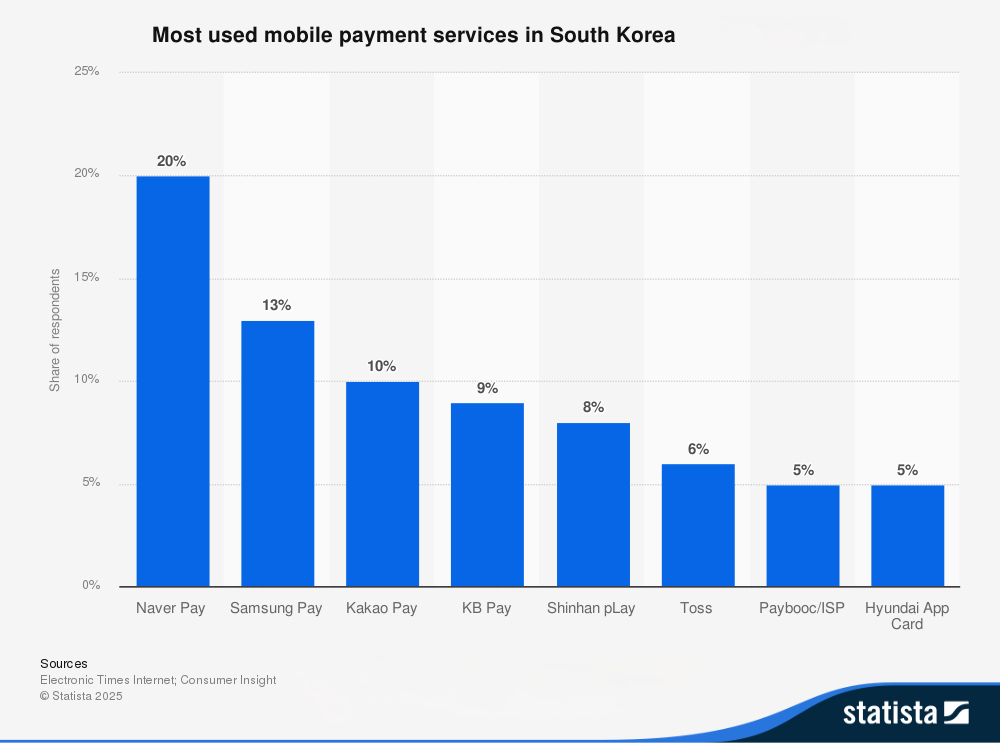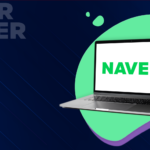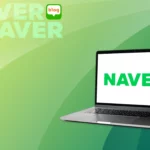E-commerce continues to grow rapidly in South Korea. At the beginning of 2025, the South Korean government released data from the previous year, revealing that online sales accounted for 52.7% of all sales – a 15% increase in online revenue compared to the year before.
This presents a highly promising opportunity for businesses aiming to promote themselves in the South Korean market. Keep reading to learn more and contact us if you are interested in taking advantage of this.
Cash or Card
South Korea is generally regarded as a cashless society – only 14% of offline transactions involve cash.
However, there is a nuance to this. It stems from the country’s inward-looking approach that emphasizes the improvement of the domestic market. Even though about 20% of citizens own a Visa and another 20% own a Mastercard, the usage is still limited (Statista, n.d.). Instead, digital wallets are the predominant payment method, accounting for 74% of all transactions (Worldpay, 2025).
The most popular digital wallets in South Korea are Naver Pay, Kakao Pay, and Samsung Pay.
- Naver Pay – launched in 2015 by Naver, the largest search engine in the country.
- Kakao Pay – introduced in 2014 by KakaoTalk, South Korea’s most-used social media platform.
- Samsung Pay – released in 2015 by Samsung, a company that holds over 75% of the local phone market share. Due to this dominance of the market by Samsung, Apple Pay has not been able to adapt to the Korean market as well as in other countries.
Read more about the South Korean nuances from a business perspective.
Advantages of using Korean payment methods
Earn trust
South Korean people have a high uncertainty avoidance rate of 85%, which shows that they are very wary before making any decisions (Hofstede, 2025). One of the most effective ways to earn their trust is by understanding and adapting to their purchasing behavior.
Make the purchasing available
As previously mentioned, only 40% of South Koreans own international credit cards like Visa and Mastercard. This means that nearly 60% of the population may not be able to make purchases from websites that do not support local payment methods such as Naver Pay, Kakao Pay, or Samsung Pay.
Why digital wallets are used in South Korea
There are 2 main types of digital wallets:
- Closed Digital Wallets – those wallets are used only within a specific platform. They are like a store gift card – can only be used at this store franchise. A prime example of such a digital wallet is Amazon Pay.
- Open Digital Wallets – those wallets can be used across multiple platforms; there are very few limitations. Most South Korean digital wallet apps fall under this category.
South Korean citizens are incentivized to use e-wallets through loyalty points, discounts set by merchants, or other perks. This encourages brand loyalty.
Moreover, the agility of the process is also one of the reasons why South Korean consumers gravitate towards digital wallets. When using international cards like Visa or Mastercard, purchases often require multiple layers of authentication – PIN codes, SMS verifications, and sometimes the card can even get locked due to being marked as “suspicious activity”. While this offers a high level of security, it often slows down the process.
In contrast, the e-wallets use biometric authentication (like fingerprint or facial recognition), which allows purchases to be completed in just seconds, which could help your business in terms of impulsive purchases.
Which digital wallet to choose – Naver Pay, Kakao Pay or Samsung Pay?
Now that you understand the advantages, you might be wondering how to implement these payment methods.
The most important step is choosing the right wallet for you – Naver Pay, Kakao Pay, or Samsung Pay. While it is great to integrate multiple of those services, only one of them is sufficient.

Naver Pay holds the biggest market of digital wallets in South Korea – 20% – thus, it is recommended that this form of payment be established. In addition, Naver is the biggest search engine in South Korea, making it a major platform for businesses to promote their products and services.
Moreover, an effective way to naturally boost SEO ranking on Naver is by having a lot of Naver properties established, such as Naver Ads, Naver Blog, and Naver Pay. This improves credibility, which is crucial for Naver SEO.
How to set up a Business Naver Pay Account
Setting up a Naver Payment method is a simple process. You have to go to the Naver Pay Partner Website and log in to an existing Naver ID (if you do not have one, you can create an account for free).
After that, you have to submit your business information, which includes:
- Business registration certificate;
- E-commerce business certificate;
- Name and contact information of your company’s representative;
- General business information;
- Account name and number where Naver will deposit the payments.
This information will be reviewed by Naver itself. Once approved, you will receive the JavaScript API that you can integrate into your website.
InterAd focuses on creating brand awareness through advertising and blog management on Naver, and advertising and SEO audits on Google. Thus, if you are having any troubles with the Naver Pays set-up process, you ought to contact a company that focuses on such integrations.
Conclusion
After reading this article, you have now familiarized yourself with the purchase behavior of South Korean people. In addition, now you know how to use this to your advantage – by implementing a Korean payment method, specifically Naver Pay.





